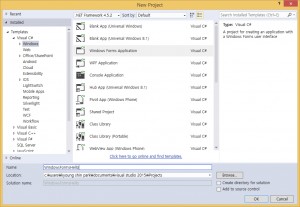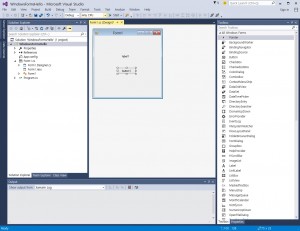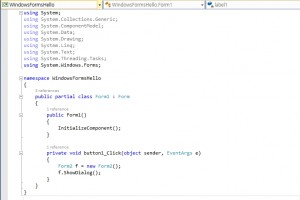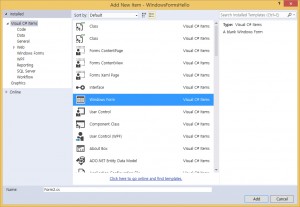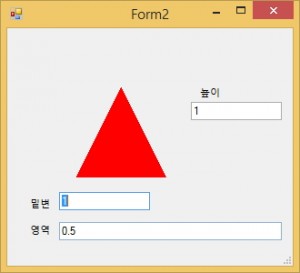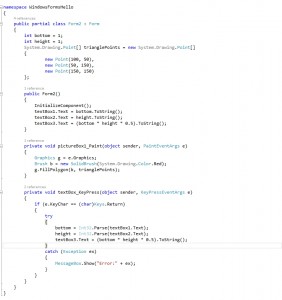lecture8
TRACE macro
TRACE macro
-윈도우 응용프로그램 개발시 Visual Studio IDE의 Output Window (출력창)에 Debug하는 내용을 출력하고자 할 때System.Diagnostics.Trace.WriteLine(…..)을 사용
-기존의 C# Console 응용프로그램에서 System.Console.WriteLine(….)와 동일
-기존의 MFC 윈도우 프로그래밍에서 TRACE 매크로와 비슷 (C의 printf와 동일한 형식 지원)
-기존의 WIN32 윈도우 프로그래밍에서 OutputDebugString 함수와 같은 기능 (C의 printf와 동일한 형식 지원)
Windows Forms Application
.NET2015
- Visual C# Windows Forms Application 프로젝트 새로 만들기
- Dialog-based App 프로젝트 새로 만들기
- 메뉴에서 File->New->Project->Visual C# 템플릿->Windows Forms Application를 선택한 후 “프로젝트 이름(예를 들어, WindowFormHello)”을 적고 확인버튼을 누르면 빈폼 프로젝트가 생성된다.
컨트롤 코드 추가
- Toolbox(도구상자) 에서 컨트롤을 선택(예를 들어, Label 또는 Button)하여 Dialog기반의 Form1 안에 추가하여 편집한다.
컨트롤에 이벤트 추가하기
-컨트롤 (예를들어, 버튼을 더블클릭하면 또는 이벤트목록중 Click이벤트에 더블클릭하면)에 클릭 이벤트에 대한 이벤트핸들러에 내용(예를 들어, 레이블의 Text를 “Button Clicked”)을 작성한다.
private void button1_Click(object sender, EventArgs e)
{
// button1을 클릭하면 label1 텍스트 변경
label1.text = “Button Clicked”;
// button1을 클릭하면 Form2 팝업
Form2 f = new Form2();
f.ShowDialog();
}
폼 코드 추가
- Project 에서 폼을 추가(Add New Item)하여 Form2 를 추가한다.
- Toolbox(도구상자) 에서 컨트롤을 선택(예를 들어, Label 또는 Textbox)하여 Dialog기반의 Form2 안에 추가하여 편집한다.
- Form2 안에 코드를 추가한다.
빌드(F7) 후 실행(F5)하기
Getting Started with Windows Forms
http://msdn.microsoft.com/en-us/library/ms229601(VS.80).aspx
- Creating a New Windows Form
- Creating Event Handlers in Windows Forms
- Adjusting the Size and Scale of Windows Forms
- Changing the Appearance of Windows Forms
- Windows Forms Controls
- User Input in Windows Forms
- Dialog Boxes in Windows Forms
- Windows Forms Data Binding
- Windows Forms Security
- ClickOnce Deployment for Windows Forms
- How to: Access Keyed Collections in Windows Forms
lecture7
LINQ
class Category
{
public string Name { get; set; }
public int ID { get; set; }
}
class Program
{
static void Main(string[] args)
{
// The Three Parts of a LINQ Query:
// 1. Data source.
int[] numbers = new int[7] { 0, 1, 2, 3, 4, 5, 6 };
// 2. Query creation.
// numQuery is an IEnumerable<int>
var numQuery =
from num in numbers
where (num % 2) == 0
select num;
// 3. Query execution.
foreach (int num in numQuery)
{
Console.Write(“{0,1} “, num);
}
Console.WriteLine();
// LIST
List<Person> pList = new List<Person>();
pList.Add(new Person(“둘리”, 1, “123-4568-9012”, “대한민국”));
pList.Add(new Person(“희동이”, 3, “000-0000-0000”, “서울”));
pList.Add(new Person(“고길동”, 2, “000-0000-0000”, “서울”));
pList.Add(new Person(“도우너”, 5, “000-0000-0000”, “온따빠야별”));
pList.Add(new Person(“또치”, 4, “000-0000-0000”, “미국”));
pList.Insert(2, new Person(“마이콜”, 6, “000-0000-0000”, “서울”));
// query syntax
IEnumerable<Person> seoulQuery =
from per in pList
where per.Address == “서울”
select per;
foreach (var per in seoulQuery)
{
Console.WriteLine(per.Name + “, ” + per.ID);
}
Console.WriteLine();
// query syntax
IEnumerable<Person> personQuery =
from p in pList
where (p.ID < 2) || (p.Address == “서울”)
orderby p.Name ascending
select p;
foreach (var p in personQuery)
{
Console.WriteLine(p.Name + “, ” + p.ID);
}
Console.WriteLine();
// method syntax
IEnumerable<Person> personQuery2 = pList.Where(p => (p.ID < 2) || (p.Address == “서울”)).OrderBy(p => p);
foreach (var p in personQuery2)
{
Console.WriteLine(p.Name + “, ” + p.ID);
}
Console.WriteLine();
// JOIN
List<Category> categories = new List<Category>()
{
new Category() { Name=”서울”, ID=1 },
new Category() { Name=”대한민국”, ID=2 },
new Category() { Name=”미국”, ID=3 },
new Category() { Name=”온따빠야별”, ID=4 },
};
var query = from p in pList
join cat in categories on p.Address equals cat.Name
select new
{
p.Name,
p.Address,
cat.ID
};
Console.WriteLine(“Join Query”);
foreach (var q in query)
{
Console.WriteLine(q.Name + “, ” + q.Address + “, ” + q.ID);
}
Console.WriteLine();
}
}
// 결과
0 2 4 6
희동이, 3
마이콜, 6
고길동, 2
고길동, 2
둘리, 1
마이콜, 6
희동이, 3
고길동, 2
둘리, 1
마이콜, 6
희동이, 3
Join Query
둘리, 대한민국, 2
희동이, 서울, 1
마이콜, 서울, 1
고길동, 서울, 1
도우너, 온따빠야별, 4
또치, 미국, 3
Array.ConvertAll
https://msdn.microsoft.com/ko-kr/library/kt456a2y(v=vs.110).aspx
public delegate TOutput Converter<in TInput, out TOutput>(
TInput input
)
static System.Drawing.Point Point2DrawingPoint(Point p)
{
return (System.Drawing.Point)p;
}
static void Main(string[] args)
{
List<Point> Vertices = new List<Point>()
{
new Point() { X = 400, Y = 10 },
new Point() { X = 300, Y = 210 },
new Point() { X = 500, Y = 210 }
};
// 1. Lambda expression
System.Drawing.Point[] points1 = Array.ConvertAll(Vertices.ToArray(), x => (System.Drawing.Point)x); // Use with Point.cs type conversion operator overload
// 2. Anonymous method
System.Drawing.Point[] points2 = Array.ConvertAll(Vertices.ToArray(), delegate(Point x) { return (System.Drawing.Point)x; });
// 3. Delegate (Converter<TInput, TOutput>)
System.Drawing.Point[] points3 = Array.ConvertAll(Vertices.ToArray(), new Converter<Point, System.Drawing.Point>(Point2DrawingPoint));
foreach (var v in Vertices)
Console.WriteLine(v);
foreach (var p in points1)
Console.WriteLine(p);
foreach (var p in points2)
Console.WriteLine(p);
foreach (var p in points3)
Console.WriteLine(p);
}
COLLECTION, INTERFACE, DELEGATE
1. Collection
서로 밀접하게 관련된 데이터를 그룹화하여 좀 더 효율적으로 처리할 수 있게 한 특수한 클래스 혹은 구조체이다.
2. Collection과 Interface
모든 닷넷 컬렉션은 ICollection<T> 인터페이스는 구현한다.
IList<T> 인터페이스는 인덱스를 사용하여 요소에 개별적으로 접근할 수 있는 컬렉션을 정의한다.
-T this [int index] { get; set; } //지정한 인덱스에 있는 요소를 가져오거나 설정
-int IndexOf(T item) //IList에서 특정 항목의 인덱스를 확인
-void Insert(int index, T item) //항목을 IList의 지정한 인덱스에 삽입
-void RemoveAt(int index) //지정한 인덱스에서 IList 항목을 제거
3. Collection과 Method와 Delegate
// Person 클래스
public class Person
{
private readonly string _name;
public string Name
{
get { return _name; }
}
private readonly int _age;
public int Age
{
get { return _age; }
}
public Person(string name, int age)
{
_name = name;
_age = age;
}
public override string ToString()
{
return string.Format(“이름 : {0}\t나이 : {1}”, _name, _age);
}
}
// List<T> 컬렉션에 Person 객체를 담는다
private static void Main(string[] args)
{
List<Person> aList = new List<Person>();
aList.Add(new Person(“둘리”, 1000));
aList.Add(new Person(“희동이”, 3));
aList.Add(new Person(“고길동”, 40));
}
// aList에 포함된 세 사람이 모두 10세 이상인지를 확인한다 => 둘리와 고길동만 만족함
private static void Main(string[] args)
{
List<Person> aList = new List<Person>();
aList.Add(new Person(“둘리”, 1000));
aList.Add(new Person(“희동이”, 3));
aList.Add(new Person(“고길동”, 40));
bool result = true;
foreach (Person p in aList)
{
if (p.Age < 10)
{
result = false;
break;
}
}
}
// aList에 포함된 세 사람이 모두 이름이 두 글자인지를 확인한다 => 둘리만 만족함
private static void Main(string[] args)
{
List<Person> aList = new List<Person>();
aList.Add(new Person(“둘리”, 1000));
aList.Add(new Person(“희동이”, 3));
aList.Add(new Person(“고길동”, 40));
bool result = true;
foreach (Person p in aList)
{
if (p.Name.Length != 2)
{
result = false;
break;
}
}
}
// 위의 두 코드가 나이가 10세이상인지 또는 이름이 두 글자인지 조건을 만족하는지를 확인하는 부분이 반복
// List<T> 컬렉션의 TrueForAll 메소드는 조건을 만족하는 메소드가 존재한다면 true반환
public delegate bool Predicate<T>(T item);
public class List<T> : …
{
…
public bool TrueForAll(Predicate<T> match)
{
bool result = true;
foreach (T item in this)
{
if (match(item) == false)
{
result = false;
break;
}
}
}
}
private static void Main(string[] args)
{
List<Person> aList = new List<Person>();
aList.Add(new Person(“둘리”, 1000));
aList.Add(new Person(“희동이”, 3));
aList.Add(new Person(“고길동”, 40));
// 10살 이상인지를 검사
bool result1 = aList.TrueForAll(IsGreaterThanTen);
// 무명 대리자를 사용하여 이름이 두 글자인지 검사
bool result2 = aList.TrueForAll(delegate(Person p)
{ return p.Name.Length == 2; });
}
private static bool IsGreaterThanTen(Person p)
{
return p.Age >= 10;
}
4. List<T> 컬랙션 클래스의 메소드와 헬퍼 대리자
public List<TOutput> ConvertAll<TOutput> (Converter<T, TOutput> converter)
-리스트 객체의 각 원소를 TOutput 형으로 변환하여 리스트로 반환
public bool Exists(Predicate<T> match)
-리스트에 있는 모든 원소 중 match 조건을 만족하는 원소가 있는지 여부를 반환
public T Find(Predicate<T> match)
-리스트에 있는 모든 원소 중 match 조건을 만족하는 첫번째 원소를 반환
public List<T> FindAll(Predicate<T> match)
-리스트에 있는 모든 원소 중 match 조건을 만족하는 모든 원소를 리스트로 반환
public int FindIndex(Predicate<T> match)
-리스트에 있는 모든 원소 중 match 조건을 만족하는 첫번째 원소의 인덱스를 반환
public int FindLastIndex(Predicate<T> match)
-리스트에 있는 모든 원소 중 match 조건을 만족하는 마지막 원소의 인덱스를 반환
public void ForEach(Action<T> action)
-리스트에 있는 모든 원소에 대해 action을 수행
public bool TrueForAll(Predicate<T> match)
-리스트에 있는 모든 원소가 match 조건을 만족하는 지 여부를 반환
<<대리자(Delegate)>>
public delegate void Action<T>(T object)
-T 형의 매개변수를 하나 받고 반환값이 없는 메소드
public delegate TOutput Converter<TInput, TOutput>(TInput input)
-TInput 형의 매개변수를 받고 이를 TOutput 형으로 변환하여 반환하는 메소드
public delegate bool Predicate<T>(T object)
-T 형의 매개변수를 받아 그것이 특정 조건을 만족하는지를 반환하는 메소드
public delegate int Comparison<T>(T x, T y)
-x, y 두 객체를 비교하는 메소드로 x가 y보다 작으면 음수, 같으면 0, 크면 양수를 반환하는 메소드
5. List<T>의 Sort 메소드
public void Sort()
public void Sort(Comparison<T> comparison)
public void Sort(IComparer<T> comparer)
public void Sort(int index, int count, IComparer<T> comparer)
-public void Sort()
즉, 매개변수가 없는 Sort 메서드(void Sort())는 List<T>의 원소인 객체와 계약을 맺었는데,
그 계약의 내용은 List<T>의 원소인 객체는 int CompareTo(T other)와 같은 메서드를 가지고 있다는 것입니다.
따라서 실제 List<T>의 원소의 객체가 무엇이든지 간에 Sort 메서드는 그 객체의 CompareTo 메서드를 호출하면 정렬을 수행할 수 있다.
List<T>의 원소인 객체는 int CompareTo(T other)를 구현하여야 한다.
즉, Person이 int CompareTo(Person other) 메소드에 이름 순으로 구현하여야 계약이 성립한다.
public class Person : IComparable<Person>
{
….
// Sort
public int CompareTo(Person other)
{
return this.Name.CompareTo(other.Name);
}
}
private static void Main(string[] args)
{
List<Person> aList = new List<Person>();
aList.Add(new Person(“둘리”, 1000));
aList.Add(new Person(“희동이”, 3));
aList.Add(new Person(“고길동”, 40));
// 이름순으로 정렬
aList.Sort();
}
-public void Sort(Comparison<T> comparison)
이번에는 이름이 아니라 나이 순으로 정렬을 하는 경우,
int CompareTo(Person other) 내부 구현을 이름이 아니라 나이를 기준으로 정렬하도록 수정한다.
이 경우 동적으로 Sort를 다르게 할수없는 문제가 있으므로,
List<T>의 원소를 비교 가능한 객체라고 전제 하는 것이 아니라,
Sort 메서드의 매개 변수로 아예 List<T>의 원소들을 비교하는 메서드를 전달하는 것입니다.
public delegate int Comparison<T>(T x, T y)
Comparison 대리자의 의미는 x가 y보다 작으면 음수, 같으면 0, 크면 양수를 반환한다는 것이다.
public static int ComparePersonByName(Person x, Person y)
{
return x.Name.CompareTo(y.Name);
}
public static int ComparePersonByAge(Person x, Person y)
{
return x.Age.CompareTo(y.Age);
}
private static void Main(string[] args)
{
List<Person> aList = new List<Person>();
aList.Add(new Person(“둘리”, 1000));
aList.Add(new Person(“희동이”, 3));
aList.Add(new Person(“고길동”, 40));
// 이름순으로 정렬
aList.Sort(ComparePersonByName);
// 나이순으로 정렬
aList.Sort(ComparePersonByAge);
}
-public void Sort(IComparer<T> comparer)
Sort가 IComparer<T> 인터페이스를 매개변수로 받아 처리할 수 있다.
int Compare(T x, T y)
public class PersonNameComparer : IComparer<Person>
{
public int Compare(Person x, Person y)
{
return x.Name.CompareTo(y.Name);
}
}
public class PersonAgeComparer : IComparer<Person>
{
public int Compare(Person x, Person y)
{
return x.Age.CompareTo(y.Age);
}
}
private static void Main(string[] args)
{
List<Person> aList = new List<Person>();
aList.Add(new Person(“둘리”, 1000));
aList.Add(new Person(“희동이”, 3));
aList.Add(new Person(“고길동”, 40));
// 이름순으로 정렬
aList.Sort(new PersonNameComparer());
// 나이순으로 정렬
aList.Sort(new PersonAgeComparer());
foreach(Person p in aList)
Console.WriteLine(p); // Person의 ToString 호출
}
C# Collection Interface Delegate
CollectionInterfaceDelegateFileIOTest
http://msdn.microsoft.com/en-us/library/system.collections.generic(v=VS.80).aspx
Collections (예로, List, ArrayList, Hashtable등)은 ICollection<T> 인터페이스를 구현한다.
List 클래스의 경우는 IList<T> 인터페이스를 또한 구현한다.
List<T> 컬랙션 클래스의 메소드 (예를 들어, Exists, Find, TrueForAll 등)는 특정 헬퍼대리자 (예를 들어, delegate void Action<T>, delegate bool Predicate<T> 등과 같은)를 사용하여, 중복되는 코드를 간결하게 만들수있다.
GENERIC LIST CLASS
<<List<T> 컬랙션 클래스의 메소드>>
public List<TOutput> ConvertAll<TOutput> (Converter<T, TOutput> converter)
-리스트 객체의 각 원소를 TOutput 형으로 변환하여 리스트로 반환
public bool Exists(Predicate<T> match)
-리스트에 있는 모든 원소 중 match 조건을 만족하는 원소가 있는지 여부를 반환
public T Find(Predicate<T> match)
-리스트에 있는 모든 원소 중 match 조건을 만족하는 첫번째 원소를 반환
public List<T> FindAll(Predicate<T> match)
-리스트에 있는 모든 원소 중 match 조건을 만족하는 모든 원소를 리스트로 반환
public int FindIndex(Predicate<T> match)
-리스트에 있는 모든 원소 중 match 조건을 만족하는 첫번째 원소의 인덱스를 반환
public int FindLastIndex(Predicate<T> match)
-리스트에 있는 모든 원소 중 match 조건을 만족하는 마지막 원소의 인덱스를 반환
public void ForEach(Action<T> action)
-리스트에 있는 모든 원소에 대해 action을 수행
public bool TrueForAll(Predicate<T> match)
-리스트에 있는 모든 원소가 match 조건을 만족하는 지 여부를 반환
<<대리자(Delegate)>>
public delegate void Action<T>(T object)
-T 형의 매개변수를 하나 받고 반환값이 없는 메소드
public delegate TOutput Converter<TInput, TOutput>(TInput input)
-TInput 형의 매개변수를 받고 이를 TOutput 형으로 변환하여 반환하는 메소드
public delegate bool Predicate<T>(T object)
-T 형의 매개변수를 받아 그것이 특정 조건을 만족하는지를 반환하는 메소드
public delegate int Comparison<T>(T x, T y)
-x, y 두 객체를 비교하는 메소드로 x가 y보다 작으면 음수, 같으면 0, 크면 양수를 반환하는 메소드
